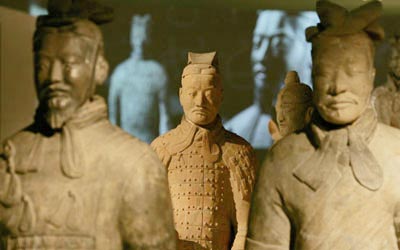Terracotta warrior figures are displayed as part of the exhibition "The First Emperor: China's Terracotta Army" at the British Museum, London Sept. 11, 2007.
Terracotta solders, musicians, chariot horses and other unearthed antiques dated back 2,000 years came under lime light at British Museum when a six-month-long exhibition started here today.
"It is a great day for British Museum and London to have such a great exhibition," said Gordon Brown, the British prime minister at the opening ceremony of the exhibition.
Though China's terra-cotta soldiers have been shown at many exhibitions outside China, the exhibition, named The First Emperor -- China's terracotta army, is the first such theme show.
The exhibition marks the strengthening of the Sino-UK relations, said Brown, adding that cultural exchange is playing an ever important role in tightening Sino-UK ties.
It is said that 100,000 tickets, each worth 12 pounds, have already been sold for the half-year-long exhibition.
Qinshihuang, the First Emperor of China, was one of the world's greatest rulers, who united China and built a vast tomb complex, hailed by many as an eternal underground empire guarded by a terracotta army.
The terracotta army, first unearthed in 1972, is regarded as both a cultural heritage and a great tourist attraction worldwide, with over two million travelers pilgriming to the Terracotta Musuem in Xi'an in northwestern China's Shaanxi Province.
(Xinhua News Agency September 12, 2007)


